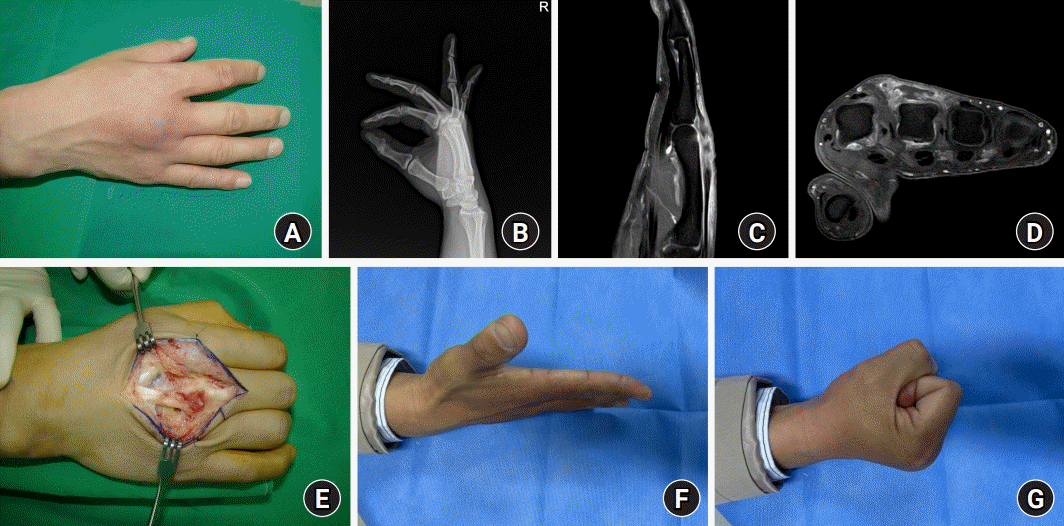A penetrating injury of the hand can easily occur during daily or professional activities and can be caused by various agents such as metal, nails, needles, glass, fish bones, wood splinters, or thorns. The risk of infection depends upon the type and properties of the foreign objects, as well as the timing and duration of symptom presentation, the location and depth of penetration, the environment of the injury, previous treatment, and the immune status of the patient [
3,
4]. A penetrating injury due to foreign material should be properly evaluated to determine whether or not surgical exploration is needed in the early stages. Because patients may not be aware of retained foreign material, physicians should make efforts to confirm the presence of foreign material and localize it [
3]. Plain radiography, ultrasonography, and computed tomography can be used to detect retained foreign material, but MRI has the limitations of cost, inspection time, expense, and the characteristics of the images [
4]. The composition of the foreign material must be confirmed because organic matters such as wood and vegetable are related to increased inflammation in soft tissue compared to metal or glass objects and as a result, has a higher risk of infection [
3,
4]. Foreign materials penetrating the skin can induce granuloma formation related to a foreign body reaction, and can mostly be treated with conservative management or removal of the foreign material [
1]. However, this injury may present as various complications, which include persistent pain, foreign body sensation or reaction, local cellulitis, synovitis or tenosynovitis, monoarthritis, abscess, infectious tenosynovitis, septic arthritis, and osteomyelitis [
5,
6]. The treatment of patients with complications should be approached by dividing the presentation into superficial and deep involvement [
7]. Also, if an infection is observed, active treatment such as antibiotics or surgical debridement should be performed [
1,
6,
8].
Because of anatomical characteristics of the dorsal hand, even deep structures such as the extensor tendon sheath and joint capsule are vulnerable by the penetrating injury, resulting in deep infections like infectious tenosynovitis or infectious arthritis. In this study, deep infection was observed as a form of delayed rupture of the EDC tendon, which has not been previously reported in the English literatures. Flexor tendon rupture secondary to a catfish spine injury was reported to occur 1 to 2 days after the initial injury, but this rupture was likely caused by the residual sharp spine [
9]. The presented cases were treated for 2 months and 4 weeks after the incident, respectively, and surgery was delayed because there was no foreign material on the initial radiography. It seems that sustained inflammation caused by a foreign body reaction continued and as a result, the tendon ruptured, and the histological examination confirmed chronic granulomatous inflammation, not a suppurative infection.
Doctors often encounter patients who are stabbed by the pointed part of a plant during outdoor activities. Although oral antibiotic administration is sometimes necessary, most can be treated conservatively or by only removing the foreign body. Since the symptoms are not severe in the early stage of injury, the diagnosis is likely to be delayed even in patients with complications [
2]. In the cases of this study, the occurrence of tendon ruptures related to plant thorn injuries was not be considered in course of conservative treatment. Therefore, if the symptoms of a finger affected by a penetrating injury do not improve, the involvement of deep structures should be suspected. MRI examination may be helpful in determining the extent of the involved lesion and the condition of the tendons. Moreover, because organic matter induces more severe inflammatory response than inorganic matter, the penetrating injury due to this matter should be observed more carefully.






 PDF
PDF Citation
Citation Print
Print



 XML Download
XML Download